Design of Broadband W-Band Waveguide Package and Application to Low Noise Amplifier Module
Abstract
:1. Introduction
2. Design of Broadband W-band Waveguide Package
2.1. Waveguide-to-Microstrip Transition Using Extended E-Plane Probe
2.2. Resonances-Free Waveguide Package
2.3. Compensation of Bond-Wire Effect
3. Experimental Results
3.1. W-Band Waveguide Transition
3.2. Bond-Wire Compensation Circuit
3.3. W-Band LNA Module
4. Conclusions
Author Contributions
Funding
Conflicts of Interest
References
- Lee, S.; Joo, J.; Choi, J.; Kim, W.; Kwon, H.; Lee, S.; Kwon, Y.; Jeong, J. W-band multichannel FMCW radar sensor with switching-TX antennas. IEEE Sens. J. 2016, 16, 5572–5582. [Google Scholar] [CrossRef]
- Jeon, Y.; Bang, S. Front-End Module of 18–40 GHz Ultra-Wideband Receiver for Electronic Warfare System. J. Electromagn. Eng. Sci. 2018, 18, 188–198. [Google Scholar] [CrossRef]
- Li, X.; Xiao, J.; Yu, J. Long-Distance Wireless mm-Wave Signal Delivery at W-band. J. Lightwave Technol. 2016, 34, 661–668. [Google Scholar] [CrossRef]
- Lee, S.; Lee, S.; Park, H.; Kim, W.; Kwon, H.; Jeong, J.; Kwon, Y. W-band dual-channel receiver with active power divider and temperature-compensated circuit. Electr. Lett. 2016, 52, 850–851. [Google Scholar] [CrossRef]
- Shahramian, S.; Holyoak, M.J.; Baeyens, Y. A 16-Element W-band Phased-Array Transceiver Chipset With Flip-chip PCB Integrated Antennas for Multi-Gigabit Wireless Data Links. In Proceedings of the IEEE Radio Frequency Integrated Circuits Symposium (RFIC), Phoenix, AZ, USA, 17–19 May 2015; pp. 27–30. [Google Scholar] [CrossRef]
- Fujiwara, K.; Kobayashi, T. Low transmission loss, simple and broadband waveguide to microstrip line transducer in V-, E- and W-band. IEICE Electr. Express 2017, 14, 20170631. [Google Scholar] [CrossRef]
- Lee, S.; Son, D.; Kwon, J.; Park, Y. Analysis of a Tapered Rectangular Waveguide for V to W Millimeter Wavebands. J. Electromagn. Eng. Sci. 2018, 18, 248–253. [Google Scholar] [CrossRef]
- Ma, X.; Xu, R. A broadband W-band E-plane waveguide to microstrip probe transition. In Proceedings of the IEEE Asia Pacific Microwave Conference, Macau, China, 16–20 December 2008; pp. 1–4. [Google Scholar] [CrossRef]
- Li, E.S.; Tong, G.X.; Niu, D.C. Full W-band waveguide to microstrip transition with new E-plane probe. IEEE Microw. Wirel. Compon. Lett. 2013, 23, 4–6. [Google Scholar] [CrossRef]
- Choe, W.; Kim, J.; Jeong, J. Full H-band waveguide-to-coupled microstrip transition using dipole antenna with directors. IEICE Electr. Express 2017, 14, 1–6. [Google Scholar] [CrossRef]
- Kim, J.; Choe, W.; Jeong, J. Submillimeter-Wave Waveguide-to-Microstrip Transitions for Wide Circuits/Wafers. IEEE Trans. Terahertz Sci. Technol. 2017, 7, 440–445. [Google Scholar] [CrossRef]
- Choe, W.; Jeong, J. A Broadband THZ On-Chip Transition Using a Dipole Antenna with Integrated Balun. Electronics 2018, 7, 236. [Google Scholar] [CrossRef]
- Jeong, J.; Kin, D.; Kim, S.; Kwon, Y. V-band High-Efficiency Broadband Power Combiner and Power-Combining module Using Double Antipodal Finline Transitions. Electr. Lett. 2003, 39, 378–379. [Google Scholar] [CrossRef]
- Ki, H. A Study on Waveguide to Microstrip Antipodal Transition for 5 G Cellular Systems. J. Inst. Internet Broadcast. Commun. (JIIBC) 2015, 15. [Google Scholar] [CrossRef]
- Zhang, Y.; Shi, S.; Martin, R.D.; Prather, D.W. Broadband SIW to waveguide transition in multilayer LCP substrates at W band. IEEE Microw. Wirel. Compon. Lett. 2017, 224–226. [Google Scholar] [CrossRef]
- Park, W.; Choe; Lee, K.; Kwon, J.; Jeong, J. Millimeter-wave waveguide transducer using extended E-plane probe. J. Inst. Internet Broadcast. Commun (JIIBC) 2018, 18, 159–165. [Google Scholar] [CrossRef]
- Ariffin, A.; Isa, D.; Malekmohammadi, A. Broadband Transition from Microstrip Line to Waveguide Using a Radial Probe and Extended GND Planes for Millimeter-Wave Applications. PIER Lett. 2016, 60, 95–100. [Google Scholar] [CrossRef]
- Aljarosha, A.; Zaman, A.U. A Wideband Contactless and Bondwire-Free MMIC to Waveguide Transition. IEEE Microw. Wirel. Compon. Lett. 2017, 27, 437–439. [Google Scholar] [CrossRef]
- Hassan, E.; Noreland, D.; Wadbro, E.; Berggren, M. Topology Optimisation of Wideband Coaxial-to-Waveguide Transitions. Sci. Rep. 2017, 7. [Google Scholar] [CrossRef] [PubMed]
- Almenti, F.; Mezzanotte, P.; Roselli, L.; Sorrentino, R. An Equivalent Circuit for the Double Bonding Wire Interconnection. In Proceedings of the IEEE MTT-S International Microwave Symposium Digest, Anaheim, CA, USA, 13–19 June 1999; pp. 633–636. [Google Scholar]
- Zhou, P.; Zheng, P.; Yu, W.; Sun, H. Design of A W-band Low Noise Amplifier Module With MMIC. In Proceedings of the 2012 5th Global Symposium on Millimeter-Waves, Harbin, China, 27–30 May 2012; pp. 5–8. [Google Scholar] [CrossRef]
- Hua, Z.; Hongfei, Y.; Peng, D.; Yongbo, S.; Xiaoxi, N.; Zhi, J.; Xinyu, L. A full W-band low noise amplifier module for millimeter-wave applications. J. Semicond. 2015, 36, 095001. [Google Scholar] [CrossRef]
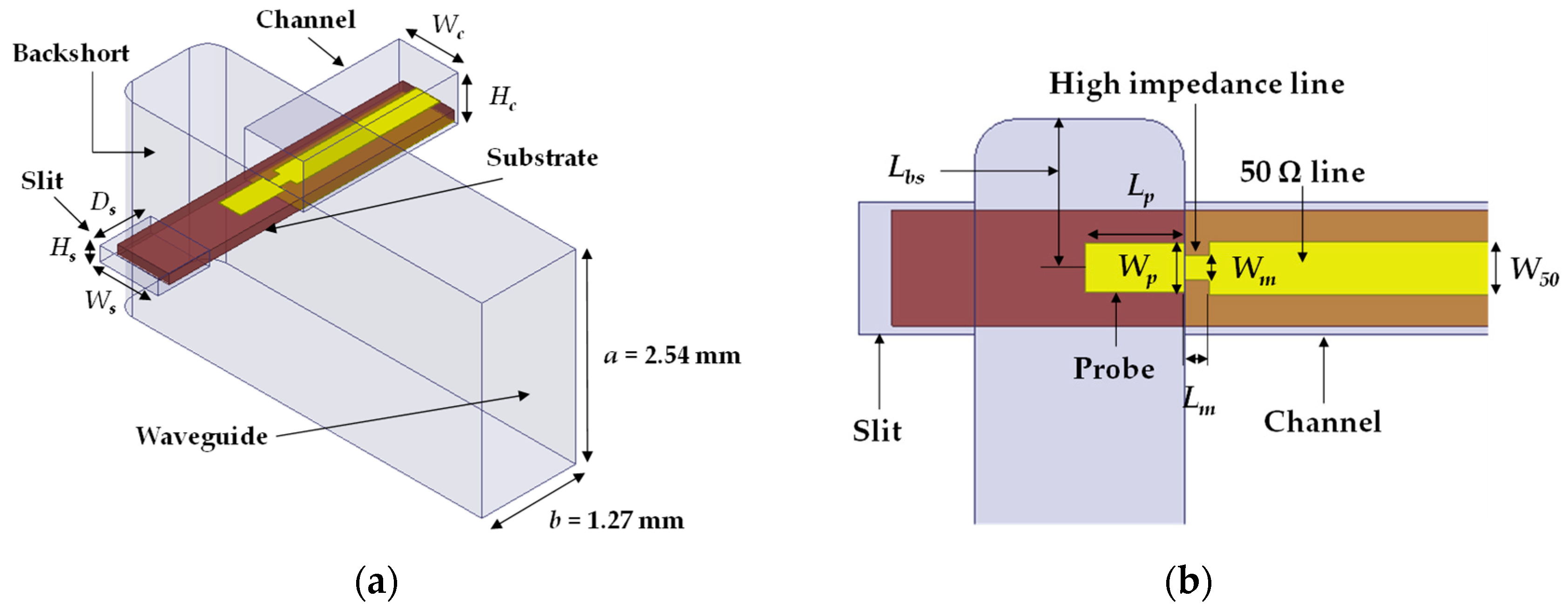

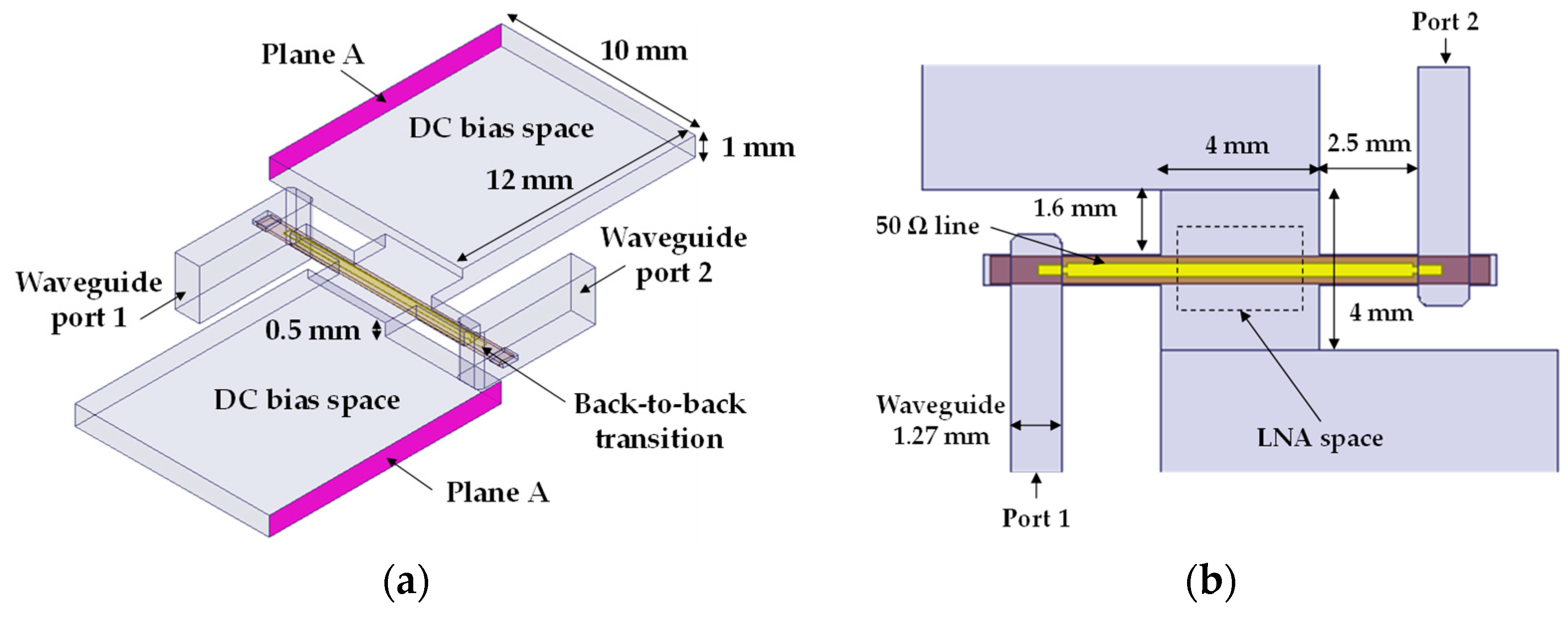

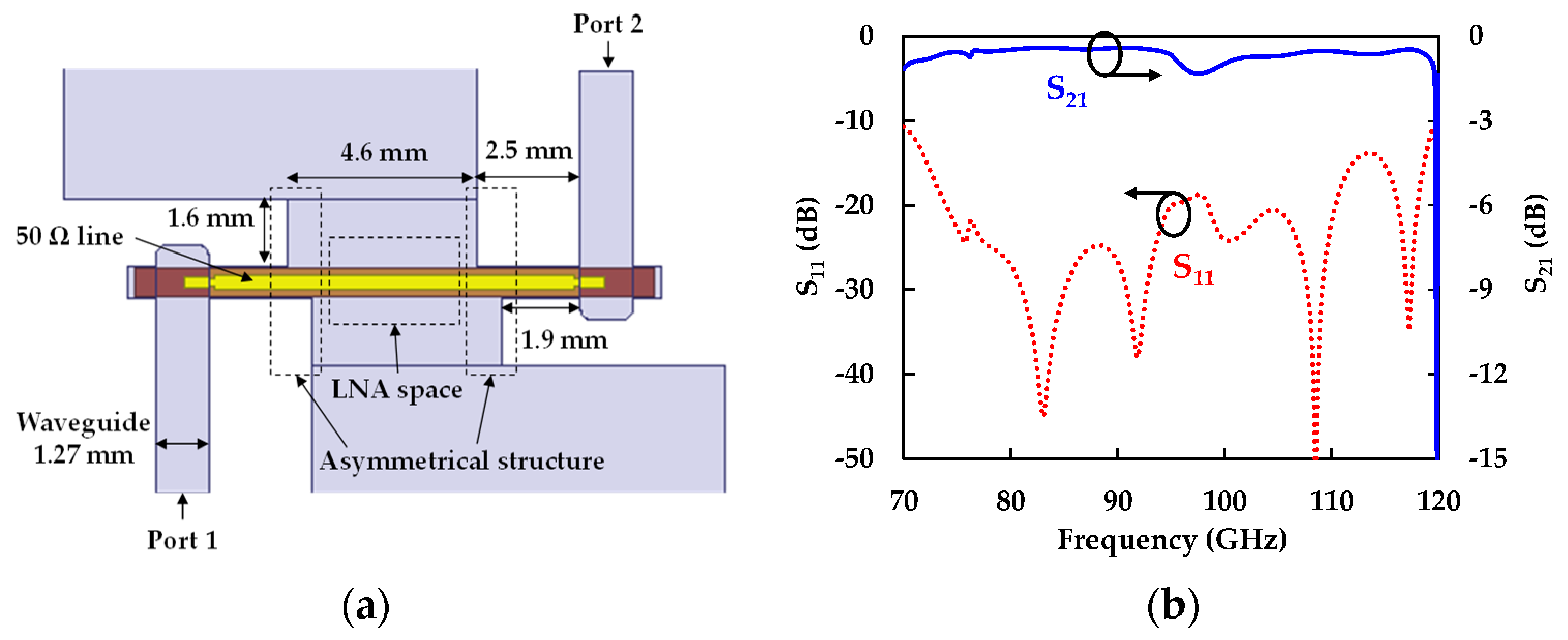

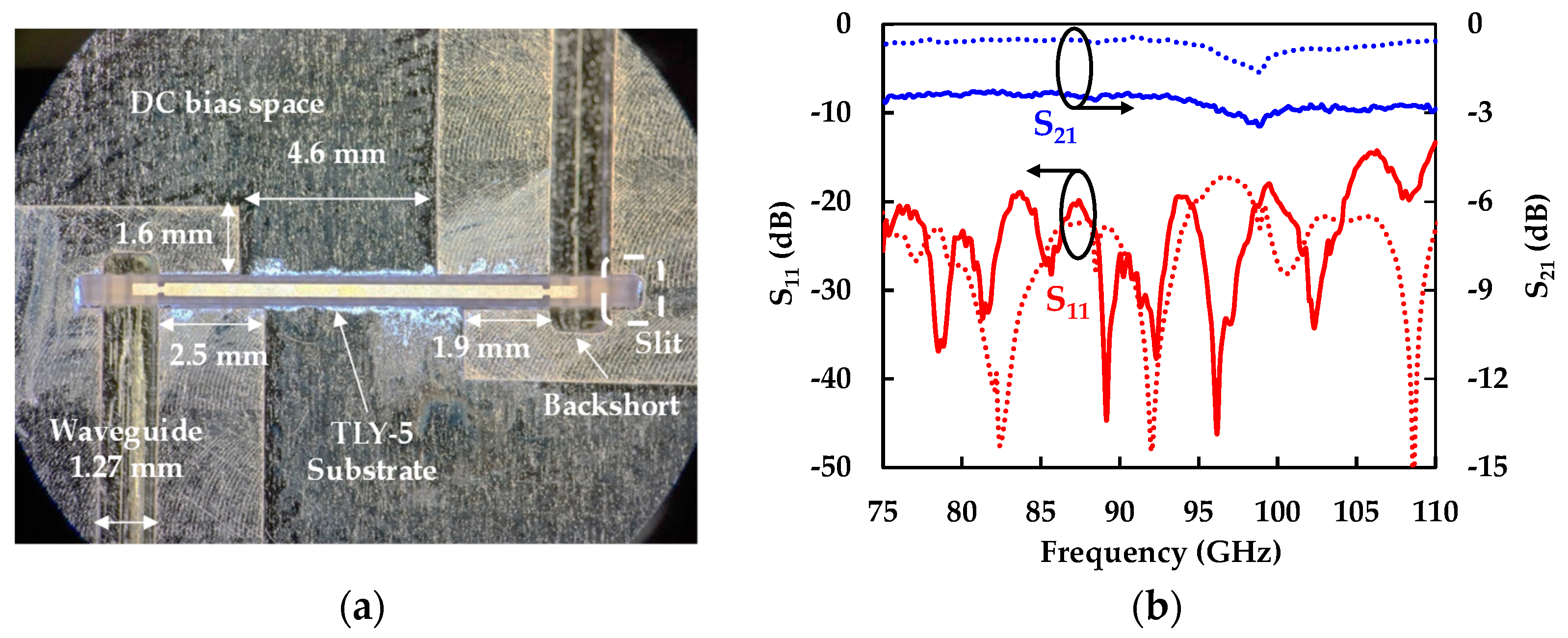

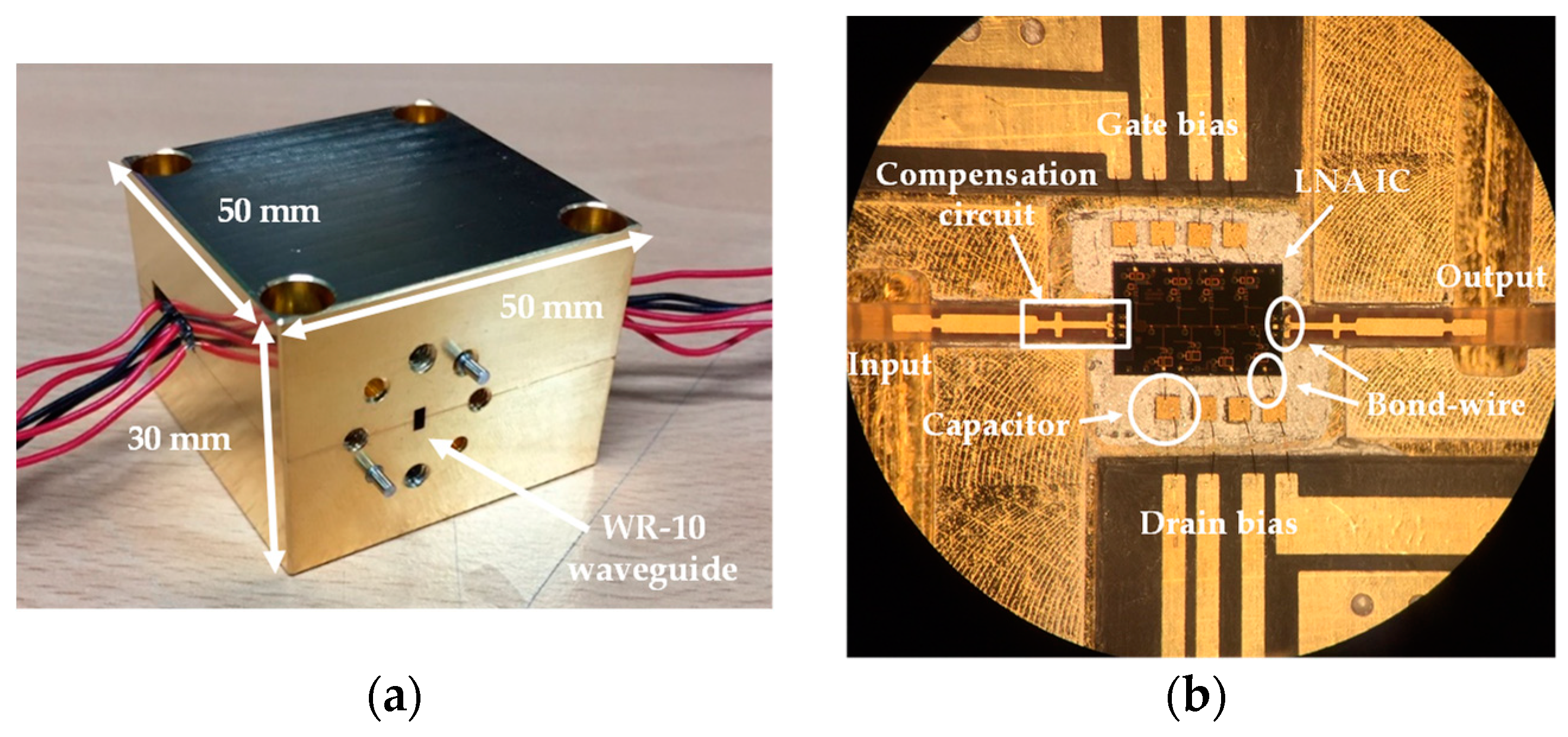

| Wp | Lp | Wm | Lm | Wc | Hc | Ws | Hs | Ds | Lbs | W50 |
|---|---|---|---|---|---|---|---|---|---|---|
| 0.3 | 0.6 | 0.15 | 0.15 | 0.8 | 0.6 | 0.8 | 0.2 | 0.7 | 0.9 | 0.32 |
© 2019 by the authors. Licensee MDPI, Basel, Switzerland. This article is an open access article distributed under the terms and conditions of the Creative Commons Attribution (CC BY) license (http://creativecommons.org/licenses/by/4.0/).
Share and Cite
Doo, J.; Park, W.; Choe, W.; Jeong, J. Design of Broadband W-Band Waveguide Package and Application to Low Noise Amplifier Module. Electronics 2019, 8, 523. https://doi.org/10.3390/electronics8050523
Doo J, Park W, Choe W, Jeong J. Design of Broadband W-Band Waveguide Package and Application to Low Noise Amplifier Module. Electronics. 2019; 8(5):523. https://doi.org/10.3390/electronics8050523
Chicago/Turabian StyleDoo, Jihoon, Woojin Park, Wonseok Choe, and Jinho Jeong. 2019. "Design of Broadband W-Band Waveguide Package and Application to Low Noise Amplifier Module" Electronics 8, no. 5: 523. https://doi.org/10.3390/electronics8050523





